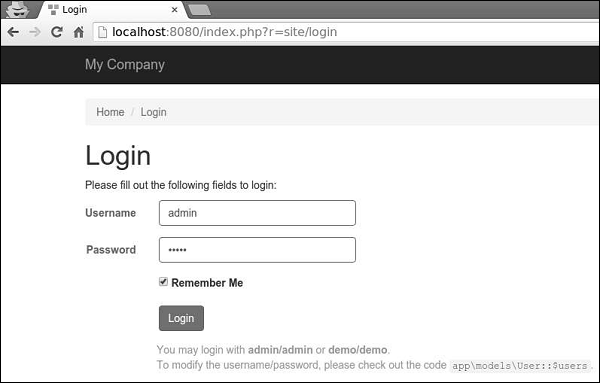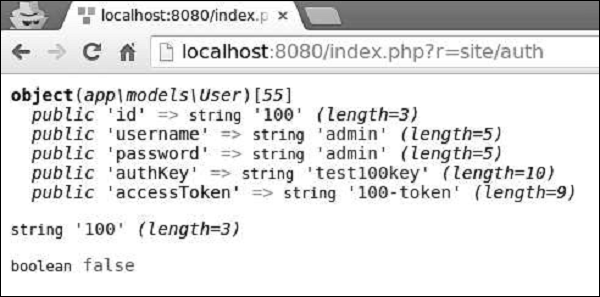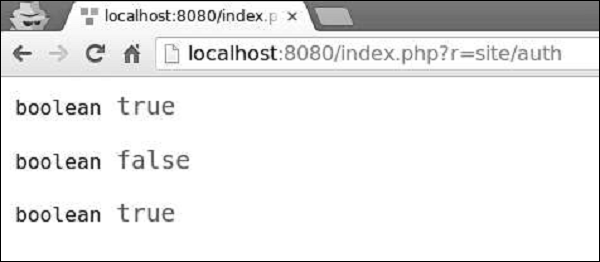
- Yii Tutorial
- Yii - Home
- Yii - Overview
- Yii - Installation
- Yii - Create Page
- Yii - Application Structure
- Yii - Entry Scripts
- Yii - Controllers
- Yii - Using Controllers
- Yii - Using Actions
- Yii - Models
- Yii - Widgets
- Yii - Modules
- Yii - Views
- Yii - Layouts
- Yii - Assets
- Yii - Asset Conversion
- Yii - Extensions
- Yii - Creating Extensions
- Yii - HTTP Requests
- Yii - Responses
- Yii - URL Formats
- Yii - URL Routing
- Yii - Rules of URL
- Yii - HTML Forms
- Yii - Validation
- Yii - Ad Hoc Validation
- Yii - AJAX Validation
- Yii - Sessions
- Yii - Using Flash Data
- Yii - Cookies
- Yii - Using Cookies
- Yii - Files Upload
- Yii - Formatting
- Yii - Pagination
- Yii - Sorting
- Yii - Properties
- Yii - Data Providers
- Yii - Data Widgets
- Yii - ListView Widget
- Yii - GridView Widget
- Yii - Events
- Yii - Creating Event
- Yii - Behaviors
- Yii - Creating a Behavior
- Yii - Configurations
- Yii - Dependency Injection
- Yii - Database Access
- Yii - Data Access Objects
- Yii - Query Builder
- Yii - Active Record
- Yii - Database Migration
- Yii - Theming
- Yii - RESTful APIs
- Yii - RESTful APIs in Action
- Yii - Fields
- Yii - Testing
- Yii - Caching
- Yii - Fragment Caching
- Yii - Aliases
- Yii - Logging
- Yii - Error Handling
- Yii - Authentication
- Yii - Authorization
- Yii - Localization
- Yii - Gii
- Gii – Creating a Model
- Gii – Generating Controller
- Gii – Generating Module
- Yii Useful Resources
- Yii - Quick Guide
- Yii - Useful Resources
- Yii - Discussion
Yii - Authentication
The process of verifying the identity of a user is called authentication. It usually uses a username and a password to judge whether the user is one who he claims as.
To use the Yii authentication framework, you need to −
- Configure the user application component.
- Implement the yii\web\IdentityInterface interface.
The basic application template comes with a built-in authentication system. It uses the user application component as shown in the following code −
<?php
$params = require(__DIR__ . '/params.php');
$config = [
'id' => 'basic',
'basePath' => dirname(__DIR__),
'bootstrap' => ['log'],
'components' => [
'request' => [
// !!! insert a secret key in the following (if it is empty) - this
//is required by cookie validation
'cookieValidationKey' => 'ymoaYrebZHa8gURuolioHGlK8fLXCKjO',
],
'cache' => [
'class' => 'yii\caching\FileCache',
],
'user' => [
'identityClass' => 'app\models\User',
'enableAutoLogin' => true,
],
//other components...
'db' => require(__DIR__ . '/db.php'),
],
'modules' => [
'hello' => [
'class' => 'app\modules\hello\Hello',
],
],
'params' => $params,
];
if (YII_ENV_DEV) {
// configuration adjustments for 'dev' environment
$config['bootstrap'][] = 'debug';
$config['modules']['debug'] = [
'class' => 'yii\debug\Module',
];
$config['bootstrap'][] = 'gii';
$config['modules']['gii'] = [
'class' => 'yii\gii\Module',
];
}
return $config;
?>
In the above configuration, the identity class for user is configured to be app\models\User.
The identity class must implement the yii\web\IdentityInterface with the following methods −
findIdentity() − Looks for an instance of the identity class using the specified user ID.
findIdentityByAccessToken() − Looks for an instance of the identity class using the specified access token.
getId() − It returns the ID of the user.
getAuthKey() − Returns a key used to verify cookie-based login.
validateAuthKey() − Implements the logic for verifying the cookie-based login key.
The User model from the basic application template implements all the above functions. User data is stored in the $users property −
<?php
namespace app\models;
class User extends \yii\base\Object implements \yii\web\IdentityInterface {
public $id;
public $username;
public $password;
public $authKey;
public $accessToken;
private static $users = [
'100' => [
'id' => '100',
'username' => 'admin',
'password' => 'admin',
'authKey' => 'test100key',
'accessToken' => '100-token',
],
'101' => [
'id' => '101',
'username' => 'demo',
'password' => 'demo',
'authKey' => 'test101key',
'accessToken' => '101-token',
],
];
/**
* @inheritdoc
*/
public static function findIdentity($id) {
return isset(self::$users[$id]) ? new static(self::$users[$id]) : null;
}
/**
* @inheritdoc
*/
public static function findIdentityByAccessToken($token, $type = null) {
foreach (self::$users as $user) {
if ($user['accessToken'] === $token) {
return new static($user);
}
}
return null;
}
/**
* Finds user by username
*
* @param string $username
* @return static|null
*/
public static function findByUsername($username) {
foreach (self::$users as $user) {
if (strcasecmp($user['username'], $username) === 0) {
return new static($user);
}
}
return null;
}
/**
* @inheritdoc
*/
public function getId() {
return $this->id;
}
/**
* @inheritdoc
*/
public function getAuthKey() {
return $this->authKey;
}
/**
* @inheritdoc
*/
public function validateAuthKey($authKey) {
return $this->authKey === $authKey;
}
/**
* Validates password
*
* @param string $password password to validate
* @return boolean if password provided is valid for current user
*/
public function validatePassword($password) {
return $this->password === $password;
}
}
?>
Step 1 − Go to the URL http://localhost:8080/index.php?r=site/login and log in into the web site using admin for a login and a password.

Step 2 − Then, add a new function called actionAuth() to the SiteController.
public function actionAuth(){
// the current user identity. Null if the user is not authenticated.
$identity = Yii::$app->user->identity;
var_dump($identity);
// the ID of the current user. Null if the user not authenticated.
$id = Yii::$app->user->id;
var_dump($id);
// whether the current user is a guest (not authenticated)
$isGuest = Yii::$app->user->isGuest;
var_dump($isGuest);
}
Step 3 − Type the address http://localhost:8080/index.php?r=site/auth in the web browser, you will see the detailed information about admin user.

Step 4 − To login and logou,t a user you can use the following code.
public function actionAuth() {
// whether the current user is a guest (not authenticated)
var_dump(Yii::$app->user->isGuest);
// find a user identity with the specified username.
// note that you may want to check the password if needed
$identity = User::findByUsername("admin");
// logs in the user
Yii::$app->user->login($identity);
// whether the current user is a guest (not authenticated)
var_dump(Yii::$app->user->isGuest);
Yii::$app->user->logout();
// whether the current user is a guest (not authenticated)
var_dump(Yii::$app->user->isGuest);
}
At first, we check whether a user is logged in. If the value returns false, then we log in a user via the Yii::$app → user → login() call, and log him out using the Yii::$app → user → logout() method.
Step 5 − Go to the URL http://localhost:8080/index.php?r=site/auth, you will see the following.

The yii\web\User class raises the following events −
EVENT_BEFORE_LOGIN − Raised at the beginning of yii\web\User::login()
EVENT_AFTER_LOGIN − Raised after a successful login
EVENT_BEFORE_LOGOUT − Raised at the beginning of yii\web\User::logout()
EVENT_AFTER_LOGOUT − Raised after a successful logout